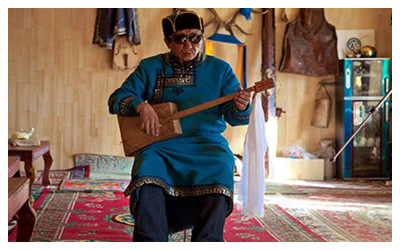Uygur Culture & Art
Much of the written Uygur literature has been passed down from the 11th century, such as the epic "Kutadolu Biliq" (Blessings and Wisdom) by Yusuf Hass Hajib, and The Turkic Dictionary by Mohamu Kashgar, which are important works for students of ancient Uygur history, culture and language. More modern works include Maulabilalibin Maulayusuf's Wars on the Chinese Land, an epic describing the 1864 struggle of the Uygurs in Ili against the Qing government. Mutalifu, the patriotic and revolutionary poet, composed poems such as "Chinese Guerrillas," "Militant Girls" and "Love and Hatred" during the Anti-Japanese War. After 19949, much work has been done to collect, compile and publish classic and folk Uygur literature.
The Uygurs are excellent at dancing. The "12 Mukams" (opera) is an epic comprising more than 340 classic songs and folk dances. After liberation, this musical treasure, which was on the verge of being lost, was collected, studied and recorded. The "Daolang Mukams," popular in Korla, Bachu (Maralwexi), Markit and Ruoqiang (Qarkilik), is another suite with distinct Uygur flavor.
 There is a wide variety of plucked, wind and percussion Uygur musical instruments, including the dutar, strummed rawap and dap. The first two are instruments with a clear and crisp tone for solo and orchestral performances. The dap is a sheep skin tambourine with many small iron rings attached to the rim. It is used to accompany dancing.
There is a wide variety of plucked, wind and percussion Uygur musical instruments, including the dutar, strummed rawap and dap. The first two are instruments with a clear and crisp tone for solo and orchestral performances. The dap is a sheep skin tambourine with many small iron rings attached to the rim. It is used to accompany dancing.
The Uygur dances, such as the "Bowls-on-Head Dance," "Drum Dance," "Iron Ring Dance" and "Puta Dance," feature light, graceful and quick-swinging choreography movements. The "Sainaim Dance" is the most popular, while the "Duolang Dance," sometimes referred to as a flower of Uygur folk culture, brims over with vitality. It depicts the hunting activities of the ancient people of Markit. The movements portray strength, wildness and enthusiasm. The "Nazilkum," popular in Turpan, Shanshan and Hami, fully reflects the Uygurs' optimism and gift for humor.

 Ask Questions ?
Ask Questions ?